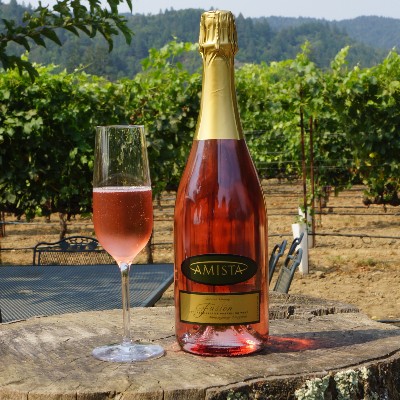On the Sparkling Wine Trail in Sonoma
Laura Sutherland showcases sparkling wineries in Sonoma, including Amista, and makes some fascinating points about the state of Sonoma sparkling in her article in Taste & Travel Magazine.
Here are her five key themes and my two cents from the perspective of an owner of the 1st sparkling winery in Healdsburg, California.
Point #1. California is Heir to the French Champagne Throne
“If Champagne, France is the king of bubbly, then California is next in line to the throne, with dazzling sparkling wines being produced throughout the state,” proclaims Laura. I agree that dazzling sparkling wines are being produced these days in California, primarily in Napa and Sonoma.
However, with a head start of centuries and Champagne’s iconic brand, I’m not sure the heir will ever ascend to the throne – at least not in my lifetime. I say that because the brand “Champagne” is akin to Coke, which is used to refer to any cola beverage, like Champagne is often used to refer to any sparkling wine.
Champagne will probably remain the king from a recognition point of view, but many California sparkling wines are of equal quality and elegance when compared with the Champagnes of France.
Point #2. Sonoma is Perfect for Growing Champagne’s Key Varietals
Although I admit to being biased, I love that the focus of the article is on Sonoma, our home in wine country. Amista Vineyards is in the heart of Sonoma in the countryside outside the charming town of Healdsburg.
Laura goes on to say, “since Sonoma sits closer to the ocean, it benefits from foggier mornings, cool misty nights and occasional sea breezes — the perfect climate for growing pinot noir and chardonnay grapes, true champagne’s key varietals.”
Chardonnay and pinot noir are the classic varieties used to make Champagne and the same varieties used by the early sparkling wineries in California. They were established by iconic French Champagne houses like Louis Roederer and Moet & Chandon, which began investing in California in the 1960s and 1970s, and they all followed the French tradition.
Point #3. Sonoma Wineries Turning out Bubbly on a Level with French Relatives
“Sonoma has boasted excellent sparkling wine producers for decades, like Iron Horse and Gloria Ferrer, but recently, more and more Sonoma wineries are turning out bubbly on a level with their French relatives,” Laura declares. I must admit, this make me happy!
We love making sparkling wines. In fact, our winemaker Ashley Herzberg and I say, “we make bubbles for ourselves and we’re happy to share them.” And we love enjoying our own wines, but it’s especially gratifying to hear that Amista and our neighboring sparkling wine houses are seen as making quality wines on par with the icons of French Champagne.
Point #4. California Winemakers Have More Creative Freedom
Agreed. And for that I am thankful. Champagne is special because of the clear restrictions on the varieties of grapes that can be used and the number of years a wine must be aged to be designated a vintage wine, among other things.
On the other hand, in this country, we have the freedom to experiment with different varieties and aging protocols, which allows us to craft unique sparkling wines.
At Amista we are on a mission to make brilliant sparkling wines from our estate grown Rhône varieties like Grenache, Syrah and Mourvèdre, although we give a nod to tradition and make a Blanc de Blanc from the Chardonnay that we grow in our estate vineyards. We love to experiment and try new varieties and blends.
Laura agrees, saying, “Pushing the envelope of what makes a great sparkling wine is one of Amista’s signatures.” This month we released the newest in our collection of sparkling wines, Sparkling Tres. It is a sparkling rosé made from Grenache, Syrah and Mourvèdre. We make a red GSM blend, so it was inevitable that a Sparkling Tres was something we had to try.
Our Sparkling Tres turned out to be a beautiful wine, in the glass and on the palate with red berry notes coupled with slivered almonds and short bread cookies. It sounds like dessert but like all our sparkling wines, it is dry with a dosage of 4g/L, which is considered Extra Brut.
Point #5. Most California Wine Made in Traditional Methode Champenoise
Although we use non-traditional grapes, all our sparkling wines are made using the traditional method for making fine French Champagne. The grapes are picked at a lower brix level (sugar content) and the wine goes through a second fermentation in its own bottle.
There are other less expensive and time-consuming ways to produce bubbles, but we remain committed to the traditional process because it delivers the highest quality sparkling wine.
Check out “On the Sparkling Wine Trail in Sonoma” by Laura Sutherland in Taste & Travel Magazine for a superb list of sparkling houses to visit in Sonoma wine country.
We hope you will put Amista Vineyards on the top of your list and Taste with Us on your exploration of Sonoma sparkling wines.
